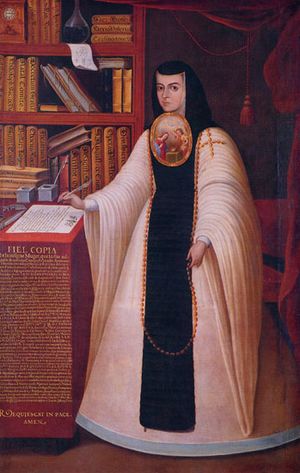María Luisa Manrique de Lara y Gonzaga facts for kids
Quick facts for kids
The Most Excellent Lady
María Luisa Manrique de Lara y Gonzaga
|
|
|---|---|
| Marchioness of la Laguna de Camero Viejo 11th Countess of Paredes de Nava |
|
| Born | 17 April 1649 Paredes de Nava, Crown of Castille |
| Died | 4 September 1721 (aged 72) Bergamo, Republic of Venice |
| Noble family | House of Lara (by birth) House of la Cerda (by marriage) |
| Spouse(s) | Tomás de la Cerda y Aragón |
| Issue | José María de la Cerda y Manrique de Lara |
| Father | Vespasiano Vincenzo Gonzaga |
| Mother | María Inés Manrique de Lara |
María Luisa Manrique de Lara y Gonzaga (born April 17, 1649 – died September 4, 1721) was an important noblewoman from Spain. She was known as the Marchioness of la Laguna and the 11th Countess of Paredes. Through her marriage, she became the Vicereine of New Spain, which was a huge Spanish territory in the Americas.
Contents
Early Life and Family
María Luisa was born on April 17, 1649, in Paredes de Nava, Spain. She was the oldest daughter of Vespasiano Vincenzo Gonzaga, who was the Viceroy of Valencia (a high-ranking governor). Her mother was María Inés Manrique de Lara, the 10th Countess of Paredes de Nava. María Luisa had siblings, including Maria Josefa. Sadly, two of her younger siblings, Isabella and Diego, passed away when they were young.
Becoming Vicereine of New Spain
María Luisa married Tomás de la Cerda, who was the 3rd Marquis of la Laguna de Camero Viejo. Because of this marriage, she became the Vicereine of New Spain. Her husband, Tomás, served as the Viceroy from 1680 to 1686. The Viceroy was like a governor who ruled the large Spanish colony of New Spain on behalf of the King of Spain.
When the new Viceroys arrived in Mexico City in 1680, two special arches were built to welcome them. One arch was designed by a famous writer named Carlos de Sigüenza y Góngora. The other arch, placed at the Mexico City Cathedral, was designed by the brilliant nun and poet, Sor Juana Inés de la Cruz. In her design, Sor Juana compared the Viceroy to Neptune, the Roman god of the sea, and María Luisa to Amphitrite, Neptune's wife and goddess of the sea.
María Luisa and Tomás had one son, José María de la Cerda y Manrique de Lara, who was born on July 5, 1683. Sor Juana also wrote poems to celebrate his birth. He was baptized a few days later in the Metropolitan Cathedral of Mexico City.
María Luisa and Sor Juana Inés de la Cruz
María Luisa was a very important supporter of Sor Juana Inés de la Cruz. She helped the nun by making sure her writings were published in Spain. This was a big deal because it helped Sor Juana's work become known to more people.
Sor Juana dedicated many poems to María Luisa. In her poems, Sor Juana often called María Luisa "Lysi." The famous writer Octavio Paz even wrote a chapter in his book about the special friendship between the Vicereine and the poet. A collection of poems that Sor Juana wrote for María Luisa was published with the title "Un amar ardiente" (An Ardent Love).
María Luisa has also been shown as a character in movies and TV shows. She appeared in the film "Yo, la peor de todas" and in the TV series "Juana Inés".
Sor Juana's play, "Los empeños de una casa" (The Pawns of a House), was performed for María Luisa and her husband. In this play, Sor Juana included special lines honoring María Luisa, calling her "Divina Lysi" (Divine Lysi).
In 1689, María Luisa helped publish Sor Juana's first book of poems, called "Inundación Castálida" (Castálida Flood), in Madrid, Spain. A second book of her poems was published a few years later in Seville.
Later Life and Death
María Luisa Manrique de Lara y Gonzaga passed away on September 4, 1721, in Bergamo, Italy.
See also
 In Spanish: María Luisa Manrique de Lara y Gonzaga para niños
In Spanish: María Luisa Manrique de Lara y Gonzaga para niños



